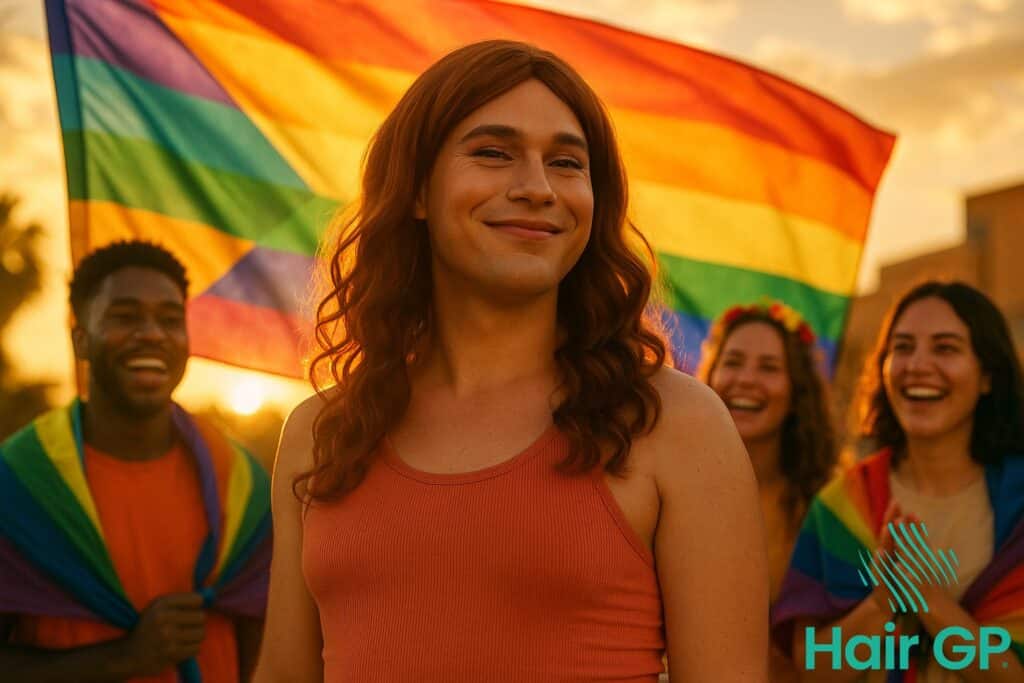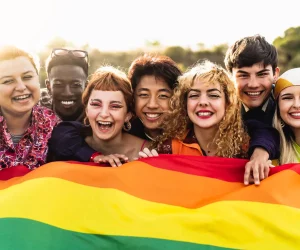Introduction
Hair plays a profound role in how we express ourselves to the world, particularly within the LGBTQ+ community where it often becomes an integral part of gender identity and personal authenticity. During Pride Month, as we celebrate the beautiful spectrum of human diversity, it’s essential to acknowledge that many individuals navigate complex relationships with their hair, whether through natural changes, medical transitions, or hair loss.
This comprehensive guide recognises that your hair journey—whether embracing wigs, exploring alternative solutions, or caring for natural hair—is deeply personal and deserving of affirming support. We understand that hair loss can impact self expression in unique ways for LGBTQ+ individuals, affecting how you present your authentic self to the world.
Throughout this guide, we’ll explore the multifaceted relationship between hair and identity in the community, from understanding how hormonal changes affect hair growth to finding gender-affirming wig styles that feel truly you. We’ll share practical advice on maintaining healthy hair during transition, discuss mental health considerations, and celebrate personal stories from community members who’ve found empowerment through their hair journeys.
Whether you’re seeking the perfect wig, learning to care for changing hair, or exploring alternatives beyond traditional solutions, this guide offers compassionate, practical support. We’ll also address creating inclusive spaces for hair care and celebrating whatever path feels right for you. Because during Pride Month and beyond, every person deserves to feel confident and affirmed in their expression, regardless of their hair status.
Key Takeaways – TL/DR
- Wigs provide crucial gender-affirming support for transgender individuals experiencing hair loss during transition
- Pride Month celebrates diverse hair journeys and the empowerment of choosing how to present yourself
- Professional hair care support and community resources are essential for mental health and confidence
- Hair loss affects LGBTQ+ individuals uniquely, requiring specialized understanding and inclusive care
- Self-love and acceptance are fundamental to navigating hair changes while embracing your authentic identity
Understanding Hair Loss in the LGBTQ+ Community
Hair loss within the LGBTQ+ community presents unique challenges that intersect with gender identity, expression, and medical transitions. For transgender individuals particularly, hair changes can significantly impact their journey of self-actualisation, as hair often serves as a crucial marker of gender presentation and personal authenticity.
Hormone Therapy and Hair Changes
Hormone replacement therapy (HRT) profoundly affects hair growth patterns in transgender individuals, with effects varying dramatically between feminising and masculinising treatments. For trans women undergoing feminising hormone therapy, oestrogen and anti-androgens can slow or halt male pattern baldness progression, with some experiencing modest regrowth in previously thinned areas [1]. The timeline of these changes typically unfolds over months to years, with noticeable improvements often appearing within 3-6 months of consistent treatment.
Conversely, trans men on testosterone therapy may experience male pattern baldness as a desired masculinising effect, though this can be distressing for those unprepared for genetic predisposition to manifest. Research indicates that approximately 64% of transgender men on long-term testosterone therapy experience some degree of androgenetic alopecia [2]. Managing expectations becomes crucial, as healthcare providers must discuss both desired and potentially unwanted hair changes before initiating hormone therapy.
The trans community often navigates complex decisions regarding hair loss prevention whilst maintaining their hormone regimens. Some individuals choose to incorporate medications like finasteride or minoxidil, though these must be carefully balanced with transition goals and overall health considerations.
Emotional Impact of Hair Loss
Hair loss can trigger profound psychological effects within the transgender community, particularly when it conflicts with gender expression goals. For trans women, male pattern baldness may exacerbate gender dysphoria, serving as an unwanted reminder of assigned sex at birth. Similarly, trans men who experience unexpected or extensive hair loss might struggle with the balance between accepting masculine traits and maintaining their desired aesthetic.
Mental health considerations remain paramount when addressing hair changes in LGBTQ+ individuals. The intersection of minority stress, transition-related challenges, and hair loss can compound existing vulnerabilities. Coping strategies often include connecting with supportive community members who share similar experiences, exploring hair restoration options, or embracing alternative expressions of gender identity that transcend traditional hair norms.
Many individuals find empowerment through reframing their relationship with hair loss, viewing it as part of their authentic journey rather than a limitation. Support groups specifically addressing appearance-related concerns in the LGBTQ+ community provide valuable spaces for processing these complex emotions whilst building resilience and self-acceptance.
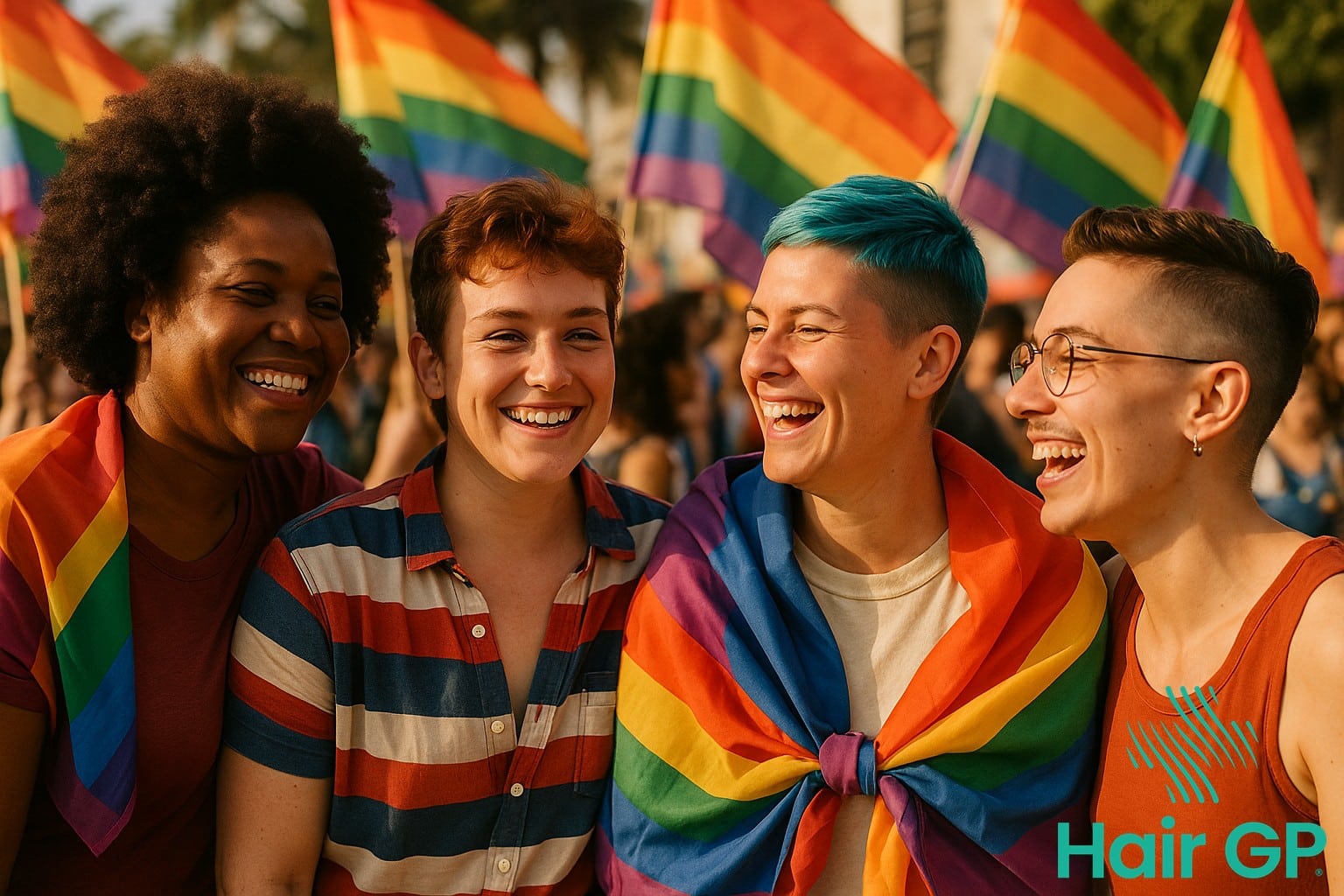
Pride Month: Celebrating Hair Diversity and Self-Expression
Pride Month serves as a vibrant celebration of authenticity, where hair becomes a powerful canvas for self-expression and identity. During this special time, countless individuals discover renewed confidence in embracing their unique hair journeys, whether through bold colours, affirming styles, or choosing wigs that reflect their true selves. The rainbow flags and festive atmosphere create a supportive backdrop for exploring how our hair can tell our stories and celebrate who we are.
The spirit of pride encourages a profound journey of self love that extends to every aspect of our appearance, including our hair. Many find this month particularly empowering for experimenting with styles they’ve long admired but hesitated to try. From vibrant rainbow dyes to gender-affirming cuts, Pride Month creates space for transformation and experimentation. For those experiencing hair loss or thinning, this celebration offers permission to view wigs not as concealment but as tools for creative expression and personal empowerment.
Throughout Pride celebrations, hair becomes a medium for community connection and shared joy. The beauty of diverse hair expressions – natural curls embraced in their full glory, carefully styled wigs in every imaginable shade, buzzcuts worn with fierce confidence – reflects the beautiful diversity of our community itself. These visible expressions of individuality help others feel validated in their own choices, creating ripples of acceptance and encouragement that extend far beyond June.
The empowerment found during Pride Month often sparks lasting changes in how individuals approach their hair and self-care routines. Many discover that the confidence gained from wearing their hair authentically during Pride carries forward into everyday life. Whether someone chooses to maintain their natural hair, embrace baldness, or express themselves through wigs, the key lies in making choices that align with personal truth rather than external expectations. This freedom to choose, supported by community celebration, transforms hair from a source of anxiety into an opportunity for joy and self-expression. The lasting impact of Pride Month reminds us that every day presents an opportunity to wear our hair – and ourselves – with pride, creating a year-round celebration of authentic beauty and individual expression.
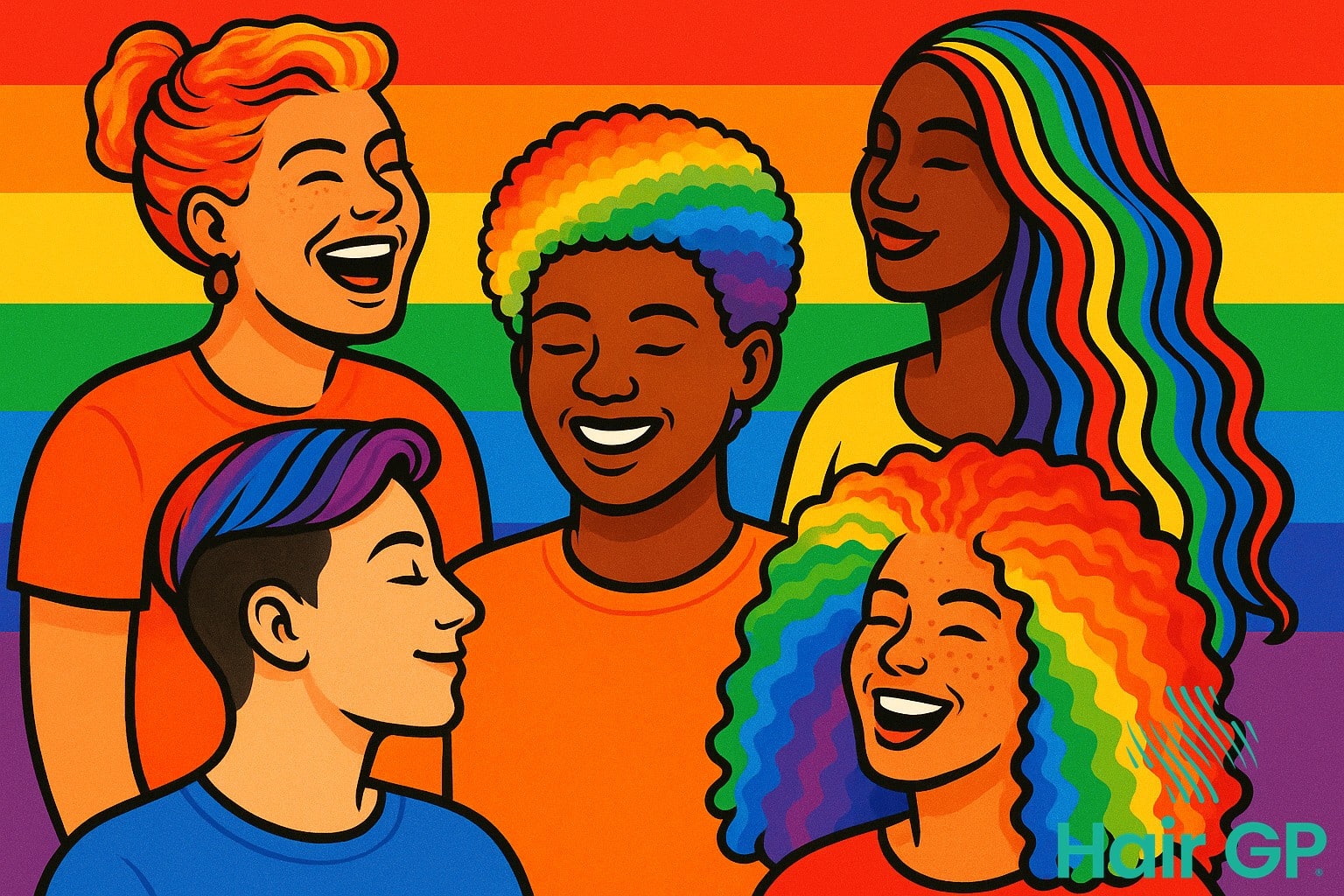
Choosing the Right Wig for Gender Affirmation
Selecting the right wig represents a crucial step in the gender affirmation journey, offering immediate transformation whilst natural hair transitions or as a permanent solution for those experiencing hair loss. Understanding style, fit, and quality considerations specific to gender-affirming needs empowers individuals to make confident choices that enhance their authentic presentation. Professional guidance combined with practical knowledge ensures the most affirming results.
Wig Styles for Different Face Shapes
Matching wig styles to facial features creates the most naturally affirming appearance, particularly important for trans women seeking to enhance femininity through strategic styling choices. Oval face shapes offer the greatest versatility, complementing virtually any wig style from pixie cuts to flowing layers. Round faces benefit from longer styles with volume at the crown, creating vertical lines that elongate facial proportions whilst side-swept fringes add angular definition.
Square face shapes harmonise beautifully with soft, layered wigs featuring gentle waves that soften angular jawlines—a common concern amongst those beginning their transition. Professional stylists recommend shoulder-length or longer styles with graduated layers starting below the chin. Heart-shaped faces shine with chin-length bobs or styles featuring fullness around the jawline, balancing wider forehead proportions whilst drawing attention to the eyes and cheekbones.
Customisation options transform standard wigs into personalised pieces that reflect individual style preferences. Many salon professionals specialise in gender-affirming services, offering expert trimming, thinning, and styling that adapts wigs to complement unique facial features. Creating a natural hairline proves particularly crucial, with techniques like plucking and baby hair creation producing remarkably authentic results that boost confidence in daily presentation.
Budget-Friendly Options
Quality synthetic wigs offer exceptional value without compromising appearance, with modern fibres mimicking human hair texture and movement remarkably well. Heat-friendly synthetic options priced between £80-200 provide styling versatility whilst maintaining affordability, lasting 4-6 months with proper care. These wigs often feature lace fronts or monofilament tops that create realistic hairline appearances essential for gender affirmation.
Human hair alternatives, whilst initially more expensive at £200-500, prove economical long-term investments lasting 1-2 years with appropriate maintenance. Online specialist retailers catering to the transgender community frequently offer payment plans, making quality wigs accessible to those on limited budgets. Many provide virtual consultations with experienced stylists who understand the unique needs of gender transition.
Community exchanges and support groups create invaluable resources for accessing pre-loved wigs at reduced costs. Trans women often share or sell wigs as their natural hair grows, fostering supportive networks whilst providing affordable options. Social media groups dedicated to gender affirmation regularly feature member-to-member sales, with prices typically 50-70% below retail. Local LGBTQ+ centres sometimes maintain wig libraries, allowing individuals to borrow styles for special occasions or trial different looks before purchasing.
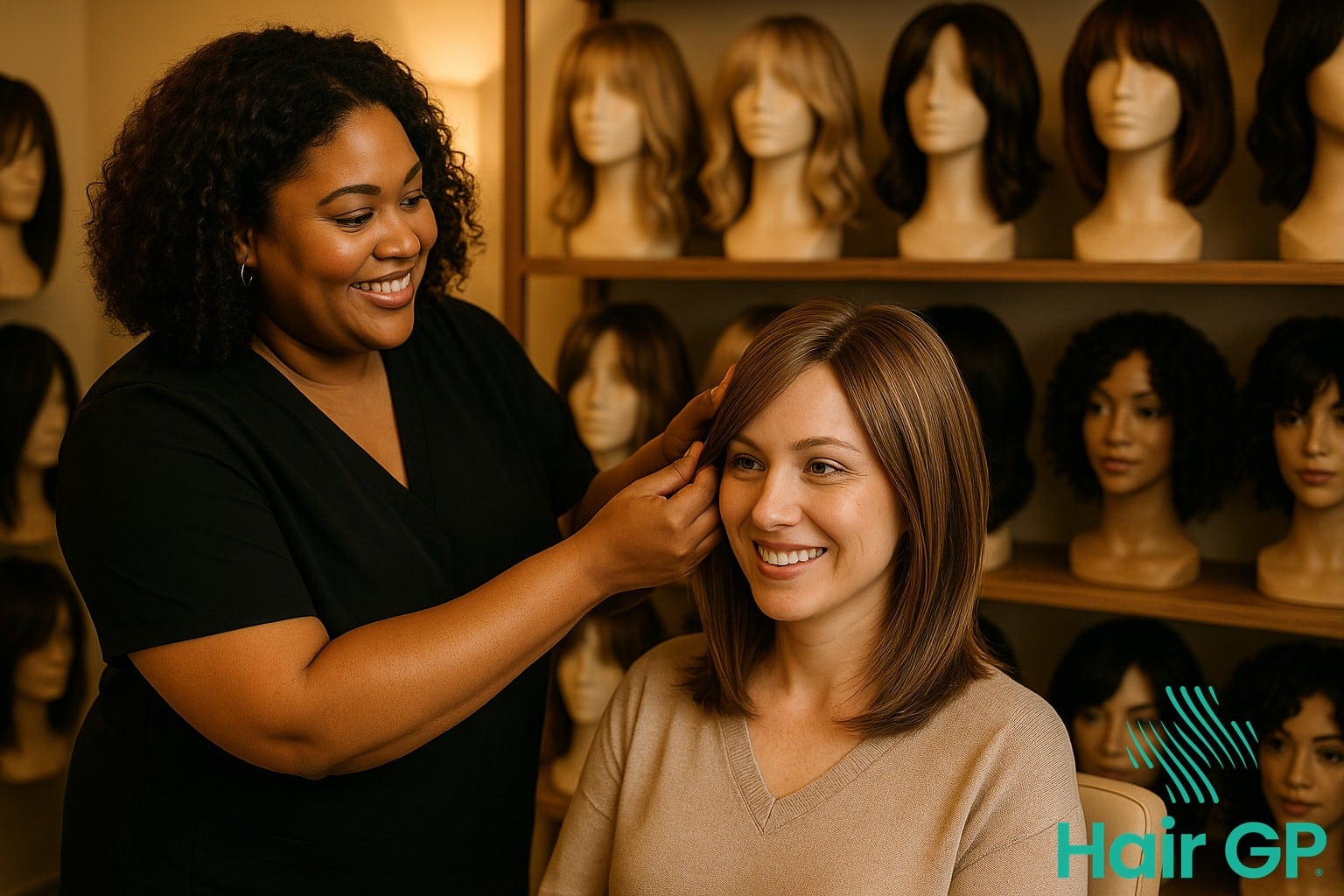
Natural Hair Care During Transition
Caring for your natural hair during gender transition requires thoughtful attention to scalp health and gentle maintenance practices. As hormone therapy can influence hair growth patterns and texture, establishing a nurturing hair care routine becomes essential for maintaining healthy hair follicles whilst navigating physical changes.
Scalp Health and Hair Growth
The foundation of healthy hair growth begins with optimal scalp conditions. Regular scalp massage has shown promising benefits, with research indicating that five minutes of daily massage can increase hair thickness by promoting blood circulation to hair follicles [3]. This simple self care practice not only supports physical wellness but also provides moments of mindful connection with your changing body.
Nutritional support plays a crucial role in maintaining hair health during transition. Whilst the effectiveness of hair growth supplements varies, studies suggest that addressing nutritional deficiencies, particularly in iron, vitamin D, and biotin, can support healthy hair follicles [4]. However, it’s important to consult healthcare providers before starting any supplement regimen, especially when undergoing hormone therapy.
Choosing gentle, sulphate-free products helps maintain the scalp’s natural balance without stripping essential oils. Look for formulations with nourishing ingredients like tea tree oil for scalp health or rosemary extract, which some studies suggest may support hair growth. Avoid harsh chemicals and excessive washing, which can stress already sensitive hair follicles during hormonal changes.
Protective Styling Techniques
When experiencing hair thinning or texture changes, protective styling becomes invaluable for maintaining your natural hair whilst promoting growth. Low-manipulation styles such as loose braids, silk-wrapped buns, or gentle twists minimise daily handling and reduce breakage. These styles allow you to maintain a polished appearance whilst giving your hair the rest it needs to thrive.
Heat protection is paramount when styling thinning hair. If using heated tools, always apply a quality heat protectant and keep temperatures below 150°C. Consider embracing air-drying methods and heat-free styling techniques like pin curls or foam rollers, which create beautiful results without damaging vulnerable strands.
Overnight care significantly impacts hair health during transition. Sleeping on silk or satin pillowcases reduces friction and moisture loss, whilst protective bonnets or scarves can prevent tangles and breakage. For longer hair, loosely plaiting or using a silk scrunchie to create a gentle pineapple style protects ends whilst you sleep. These simple adjustments to your nightly routine can make substantial differences in maintaining healthy natural hair throughout your transition journey.
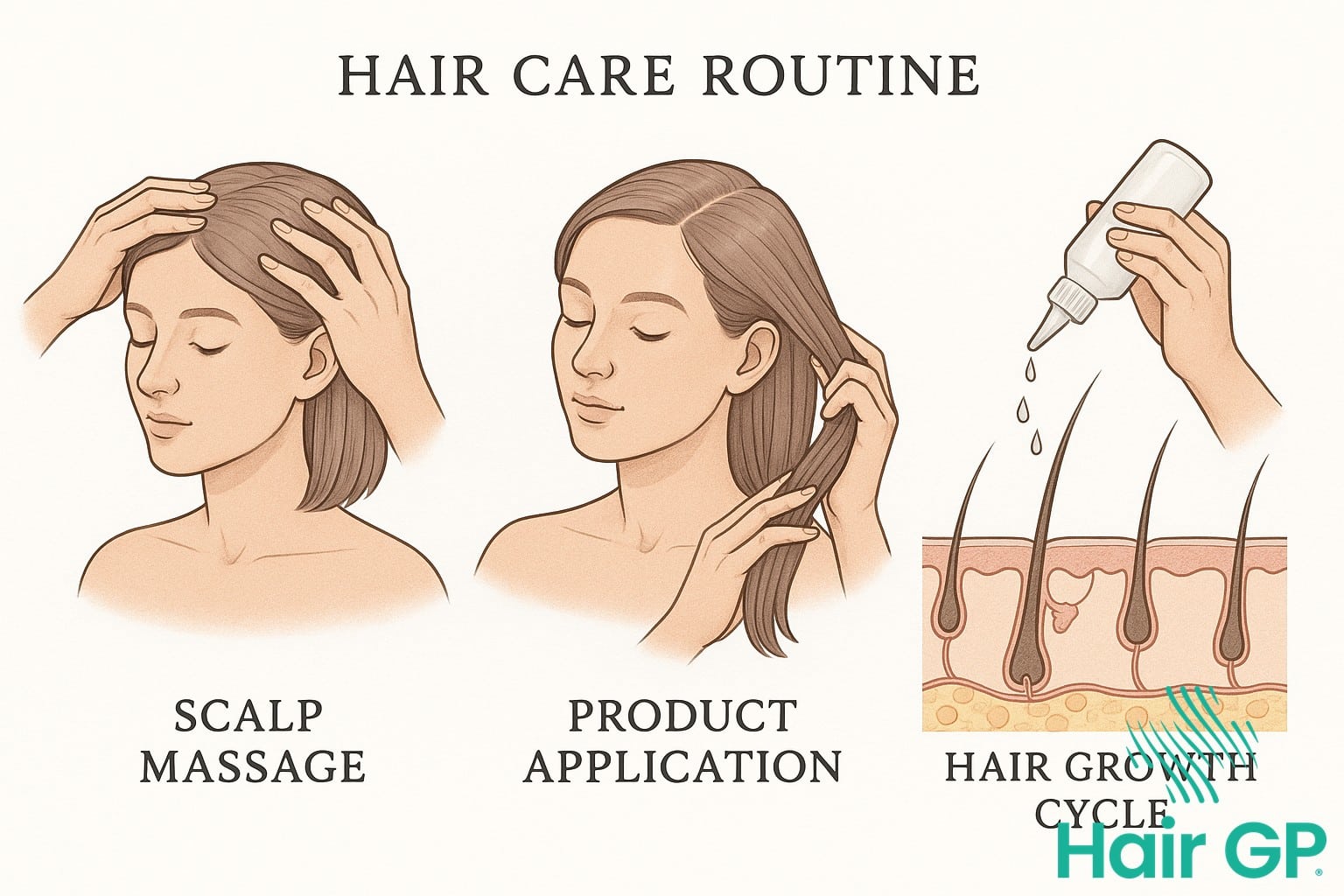
Mental Health Support and Hair Loss
Hair loss profoundly affects emotional wellbeing, with research demonstrating significant psychological impacts that extend beyond physical appearance. Understanding this connection empowers individuals to develop healthy coping strategies whilst embracing diverse expressions of beauty and identity.
Building Confidence Beyond Hair
Developing self-worth independent of physical appearance creates lasting resilience against societal beauty standards. Research indicates that individuals experiencing hair loss often report decreased self-esteem and social anxiety[5], making intentional confidence-building practices essential for mental health maintenance.
Daily affirmation practices help reframe negative thought patterns surrounding appearance. Creating personalised mantras that celebrate inner qualities, achievements, and unique characteristics shifts focus from perceived deficits to genuine strengths. Writing these affirmations and placing them in visible locations reinforces positive self-perception throughout challenging moments.
Reframing beauty standards involves actively challenging narrow definitions of attractiveness. Many cultures throughout history have celebrated diverse appearances, including baldness as a symbol of wisdom and strength. Engaging with media featuring confident individuals with various hair presentations helps normalise different aesthetic expressions.
Celebrating other features redirects attention to the multitude of attractive qualities beyond hair. Emphasising expressive eyes, radiant smiles, elegant bone structure, or graceful movements cultivates appreciation for the body’s inherent beauty. Photography sessions focusing on these features often reveal previously unrecognised attractiveness, building lasting confidence.
Professional Support Resources
Finding therapists who understand both gender identity and appearance concerns significantly improves therapeutic outcomes. LGBTQ-affirming mental health professionals possess specialised training in addressing intersectional challenges, including the unique emotional impact of hair changes within gender transition contexts[6].
Qualified therapists employ evidence-based approaches like cognitive behavioural therapy to address appearance-related distress. These professionals help clients develop practical coping strategies whilst validating the genuine emotional challenges hair loss presents. Many practitioners now offer telehealth services, increasing accessibility for those in remote areas or preferring home-based support.
Support groups provide invaluable peer connections, whether meeting locally or through online communities. Sharing experiences with others navigating similar challenges reduces isolation whilst offering practical advice. Many groups specifically cater to transgender individuals, creating safe spaces to discuss hair-related concerns within broader transition experiences.
Online communities offer 24/7 emotional support through moderated forums and social media groups. These platforms enable anonymous participation for those not ready for face-to-face interactions. Members share styling tips, recommend supportive professionals, and celebrate confidence milestones together.
Integrating wellness practices enhances overall mental health resilience. Mindfulness meditation, regular exercise, and creative expression provide healthy outlets for processing emotions. Many find that embracing holistic self-care naturally increases self-love and acceptance, creating sustainable emotional wellbeing beyond appearance concerns.
Wig Care and Maintenance Essentials
Proper maintenance transforms quality wigs into lasting investments that maintain their natural appearance for months or years. Understanding essential care techniques ensures your chosen hairstyles remain fresh and manageable, whether you prefer short bobs or long hair styles. With the right approach, taking care of your wig becomes a simple routine that preserves both style and comfort.
Daily Wig Care Routine
Establishing consistent daily habits keeps wigs looking their best with minimal effort. Begin each morning by gently detangling using a wide-tooth comb or specialised wig brush, starting from the tips and working upwards to prevent unnecessary stress on fibres. This technique proves especially crucial for maintaining long hair wigs without causing matting or breakage.
Proper storage significantly extends wig lifespan between wears. Place your wig on a dedicated stand or mannequin head to maintain its shape, avoiding cramped spaces that create unwanted creases. For quick refreshes throughout the day, lightly mist synthetic wigs with specialised spray or use dry shampoo on human hair pieces to absorb excess oils.
Evening hair care involves removing any styling products and allowing the wig to air out overnight. This simple practice prevents product buildup whilst maintaining the integrity of various hairstyles you’ve created during wear.
Deep Cleaning and Restoration
Monthly deep cleaning rejuvenates wigs and removes accumulated residue that daily care cannot address. Fill a basin with cool water and add specialised wig shampoo, avoiding regular hair care products that may damage delicate fibres. Submerge the wig completely, gently swishing without rubbing or wringing, which preserves the original style and prevents tangling.
Conditioning treatments restore softness and manageability, particularly for human hair wigs exposed to daily styling. Apply conditioner from mid-length to ends, avoiding the cap area where product buildup causes slippage. Leave treatments for five minutes before thoroughly rinsing with cool water.
Proper drying techniques prevent damage whilst maintaining style integrity. Gently blot excess water with a microfibre towel, then place wigs on stands in well-ventilated areas away from direct heat. Synthetic pieces typically dry within hours, whilst human hair may require overnight drying. Once completely dry, style as desired using appropriate heat settings for the specific wig type.
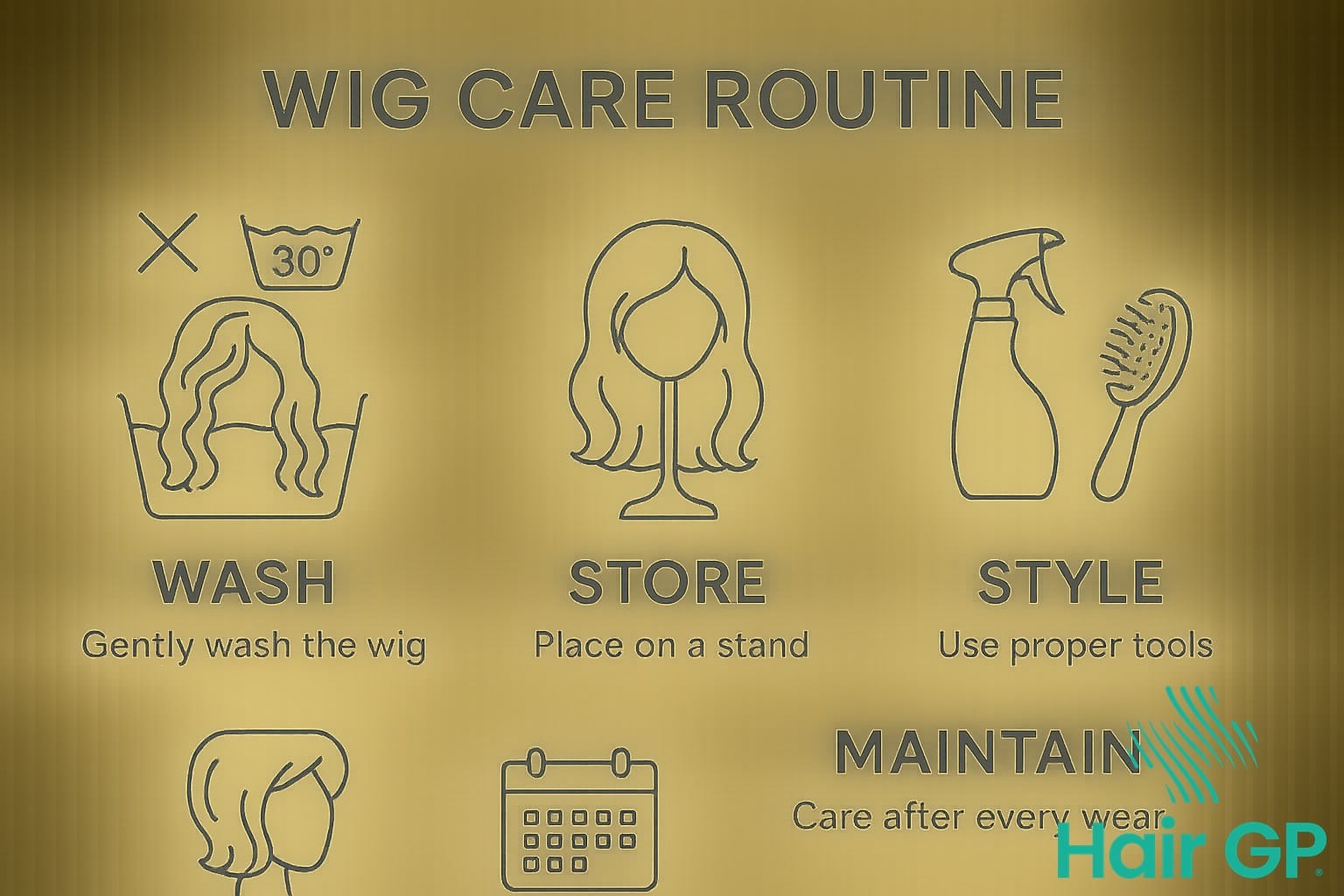
Creating Inclusive Hair Spaces
Creating truly inclusive hair spaces requires more than rainbow flags and diversity statements. A genuinely welcoming salon embodies inclusivity through actions, training, and consistent practice. This begins with stylists who understand that hair care extends beyond technical skills to encompass emotional intelligence and cultural competence. Progressive salons invest in comprehensive training programmes that educate staff about diverse gender expressions, appropriate language use, and the unique needs of LGBTQ+ clients. These spaces prioritise comfort through practical measures like gender-neutral changing areas, inclusive intake forms, and pricing structures that don’t discriminate based on perceived gender.
Finding affirming hair professionals often relies on community networks and personal recommendations. Many transgender women share their experiences through online forums and social media groups, creating invaluable resources for those seeking supportive stylists. LGBTQ+ organisations frequently maintain directories of vetted, inclusive businesses, whilst some salons actively pursue certifications that demonstrate their commitment to serving diverse clients. When researching potential stylists, look for professionals who showcase diverse portfolios, use inclusive language in their marketing, and explicitly welcome all gender identities. Initial consultations provide opportunities to gauge comfort levels and ensure alignment between client needs and stylist expertise.
Advocacy plays a crucial role in transforming the broader beauty industry. Forward-thinking salon owners partner with trans community organisations to develop best practices and create mentorship programmes. These collaborations often result in specialised services, such as wig styling sessions for those undergoing transition or chemotherapy, and educational workshops about hair care during hormone therapy. Some establishments designate specific times for LGBTQ+ clients who may feel more comfortable in dedicated spaces, whilst others focus on creating universally welcoming environments throughout operating hours.
The impact of inclusive hair spaces extends far beyond individual appointments. When salons embrace diversity, they become community hubs where authentic self-expression flourishes. Stylists who champion inclusivity often report deeper client relationships and enhanced professional satisfaction. These spaces foster connections between clients who might otherwise feel isolated, creating support networks that extend beyond hair care. As more establishments recognise the importance of serving all clients with dignity and respect, the industry gradually shifts towards universal accessibility. This evolution benefits everyone, as inclusive practices often improve overall service quality and create more innovative, creative environments where both stylists and clients can thrive.
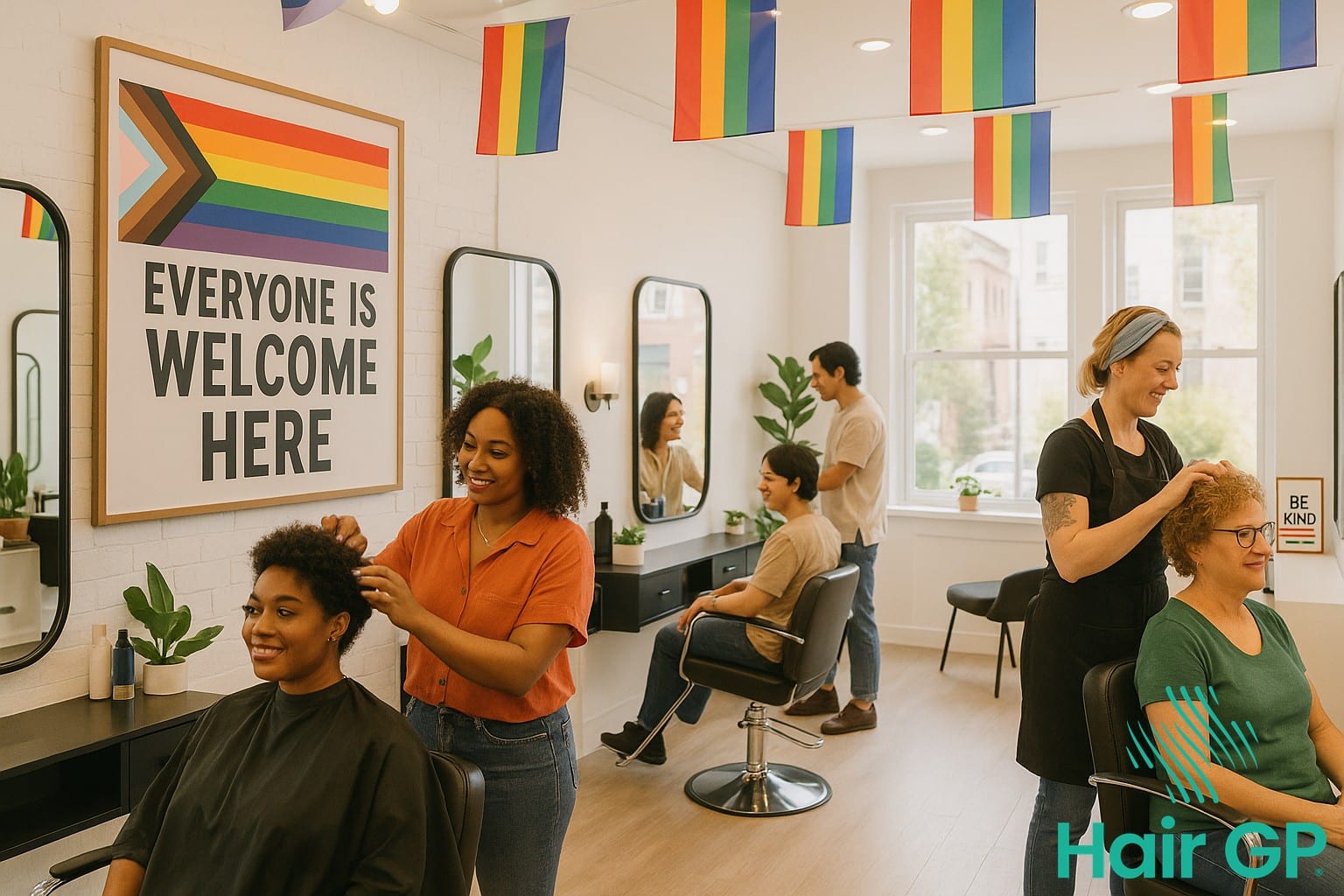
Beyond Wigs: Alternative Hair Solutions
Whilst wigs offer comprehensive coverage, numerous alternatives exist for managing hair loss and expressing your authentic self during your transitioning journey. These solutions range from partial coverage options to creative styling choices that celebrate your unique beauty, providing flexibility for different stages of hair thinning or personal preferences.
Hair toppers present an excellent middle ground for those experiencing partial hair loss or thinning at the crown. These smaller hairpieces clip seamlessly into existing hair, adding volume and coverage exactly where needed. Unlike full wigs, toppers allow you to blend your natural hair with added pieces, creating a more gradual transformation that many find easier to adjust to emotionally and practically.
Hair extensions offer another versatile solution, particularly effective for adding length and fullness to thinning areas. Clip-in extensions provide temporary enhancement for special occasions, whilst tape-in or micro-bead options offer semi-permanent solutions lasting several weeks. These methods work exceptionally well for those whose hair loss follows specific patterns, allowing targeted enhancement without full coverage.
Scarves, turbans, and decorative head wraps have emerged as fashionable alternatives that combine practicality with style. These accessories offer endless possibilities for self-expression through colours, patterns, and tying techniques. Many find that mastering various wrapping styles becomes an enjoyable aspect of their daily routine, transforming necessity into creative expression.
Embracing baldness or very short hair represents a powerful choice that challenges traditional beauty standards. Many individuals discover renewed confidence in showcasing their natural appearance, finding liberation in authenticity. This path often involves exploring makeup techniques to enhance facial features, such as defining eyebrows or creating the illusion of a hairline with clever contouring.
The journey of managing hair changes during transitioning remains deeply personal, with no single ‘correct’ approach. Whether choosing toppers for subtle enhancement, experimenting with colourful scarves, or confidently embracing a bald aesthetic, each option offers unique advantages. The key lies in selecting solutions that align with your comfort level, lifestyle, and evolving sense of self, remembering that beauty manifests in countless forms beyond traditional hair presentation.
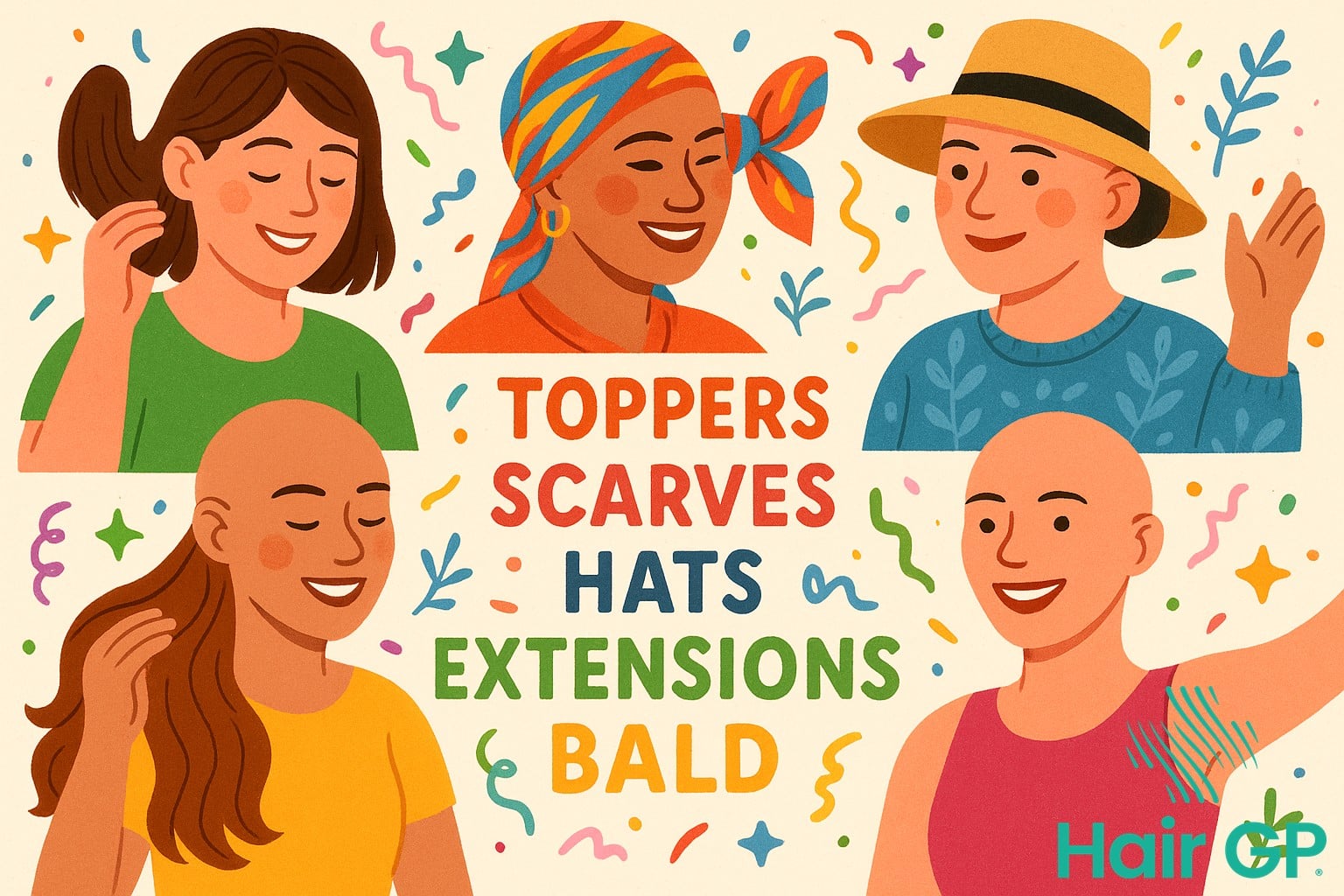
Celebrating Your Authentic Hair Journey
Your hair journey represents so much more than follicles and styling products – it’s a powerful avenue for discovering and expressing your authentic self. Whether you’re experiencing regrowth, exploring different styling options, or finding creative solutions that work for you, each step forward deserves recognition. The courage to navigate hair changes whilst staying true to yourself demonstrates remarkable strength and resilience.
Finding empowerment through your hair choices means acknowledging that there’s no single ‘right’ way to approach this journey. Some days might feel more challenging than others, and that’s entirely natural. What matters is recognising that every decision you make – from choosing a particular treatment to selecting a wig that makes you smile – represents an act of self-care and self expression. These choices reflect your unique personality and values, creating a narrative that’s entirely your own.
Building genuine confidence often comes from unexpected moments: the first time someone compliments your new style, discovering a look that truly feels like ‘you’, or simply feeling comfortable in your own skin. These milestones, however small they might seem, contribute to a deeper sense of self-acceptance. When you embrace your individual path, you give others permission to do the same, creating ripples of positivity within your community.
Remember that your worth extends far beyond your appearance, yet taking pride in how you present yourself to the world remains valid and important. Whether you’re sporting natural growth, wearing a fabulous wig, or confidently showcasing a shaved head, your choices deserve celebration. Your hair journey intertwines with your broader story of becoming who you’re meant to be – a testament to your authenticity, courage, and unwavering commitment to living as your true self.
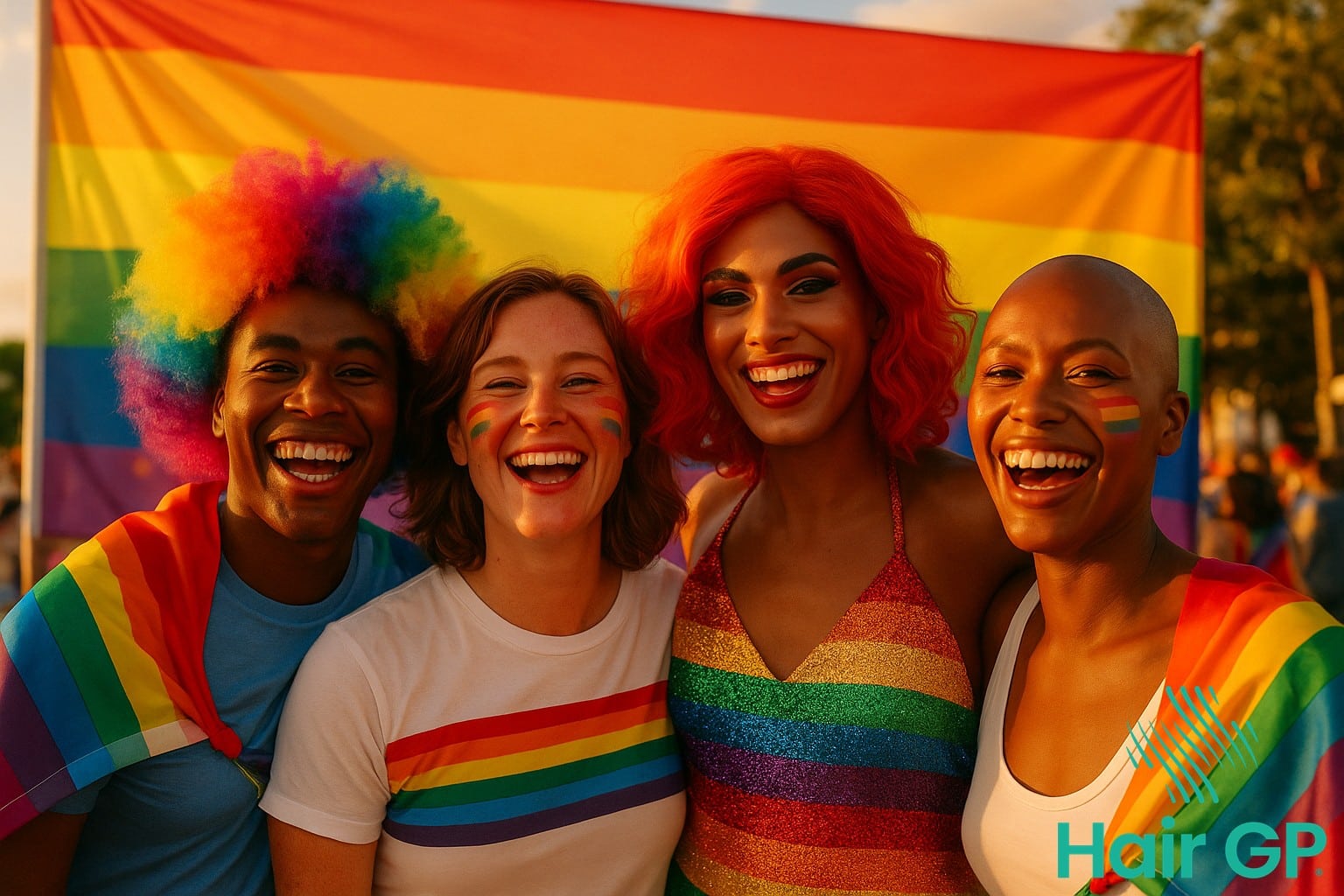
Conclusion
As Pride Month illuminates the beauty of diverse identities, we recognise that every hair journey tells a unique story of self-discovery and courage. Whether navigating hair loss, embracing wigs as creative expression, or celebrating natural textures, each path leads towards the same destination: authentic self-expression and unwavering self love.
The intersection of hair and identity runs deeper than aesthetics—it’s about claiming space, honouring experiences, and finding empowerment in our choices. For those experiencing hair loss, whether through medical conditions, gender transition, or other circumstances, know that your journey is valid and your beauty undiminished. Wigs offer not just solutions but opportunities for transformation and play, allowing exploration of different facets of identity.
Beyond Pride Month, the commitment to celebrating diverse hair stories must continue. Every twist, curl, colour, and texture—whether grown or worn—represents a step towards living as our authentic self. In salons, communities, and daily interactions, we must foster spaces where all hair journeys are honoured.
Your hair story, in all its complexity and beauty, deserves celebration. Through acceptance, support, and radical self love, we create a world where everyone can express their truth—one strand at a time.
Frequently Asked Questions
HRT can significantly impact hair patterns. For trans women, estrogen and anti-androgens often reduce male pattern baldness and may promote some regrowth. For trans men, testosterone can trigger male pattern baldness. Results vary greatly between individuals, and changes typically occur gradually over months to years.
Look for salons that display inclusive signage, use preferred pronouns, have diverse staff, and show experience with gender-affirming hair services. Many salons now advertise as LGBTQ-friendly or have specific training in serving transgender clients. Don’t hesitate to call ahead and ask about their experience and policies.
Yes, several organizations offer wig assistance programs for LGBTQ+ individuals. Some places offer payment plans whilst some wig banks specifically serve the transgender community.
Listen without judgment, validate their feelings, and offer practical support like researching wig options or accompanying them to appointments. Avoid making assumptions about their hair goals, and remember that everyone’s transition journey is unique. Small gestures of support can make a significant difference.
Wigs provide full head coverage and complete style change, while hair toppers (or hairpieces) clip onto existing hair to add volume and coverage to specific areas like the crown or part line. Toppers can be ideal for those experiencing partial hair loss who want to blend with their natural hair.
References
- Gao Y, Maurer T, Mirmirani P. Understanding and Addressing Hair Disorders in Transgender Individuals. Am J Clin Dermatol. 2018;19(4):517-527.
- Marks DH, Penzi LR, Ibler E, et al. The Medical and Psychosocial Associations of Alopecia: Recognizing Hair Loss as More than a Cosmetic Concern. Am J Clin Dermatol. 2019;20(2):195-200.
- Koyama T, Kobayashi K, Hama T, Murakami K, Ogawa R. Standardized Scalp Massage Results in Increased Hair Thickness by Inducing Stretching Forces to Dermal Papilla Cells in the Subcutaneous Tissue. Eplasty. 2016;16:e8.
- Almohanna HM, Ahmed AA, Tsatalis JP, Tosti A. The Role of Vitamins and Minerals in Hair Loss: A Review. Dermatol Ther (Heidelb). 2019;9(1):51-70.
- Hunt N, McHale S. The psychological impact of alopecia. BMJ. 2005;331(7522):951-953.
- Dhejne C, Van Vlerken R, Heylens G, Arcelus J. Mental health and gender dysphoria: A review of the literature. Int Rev Psychiatry. 2016;28(1):44-57.

